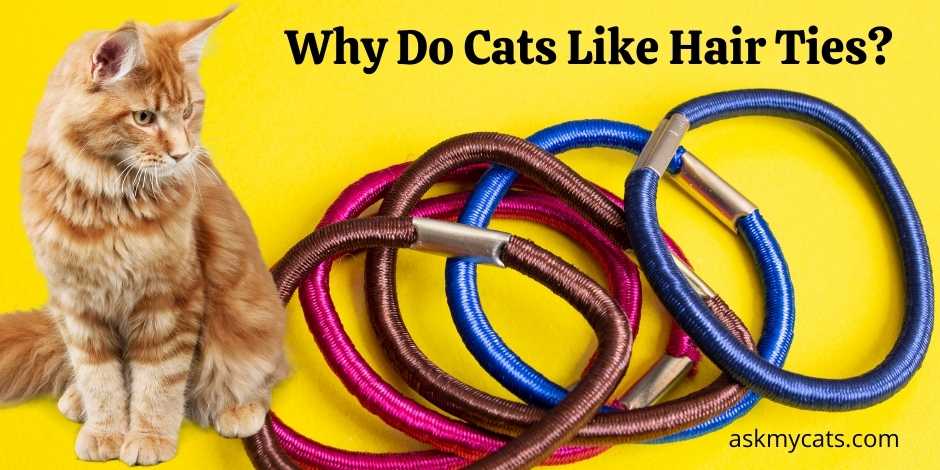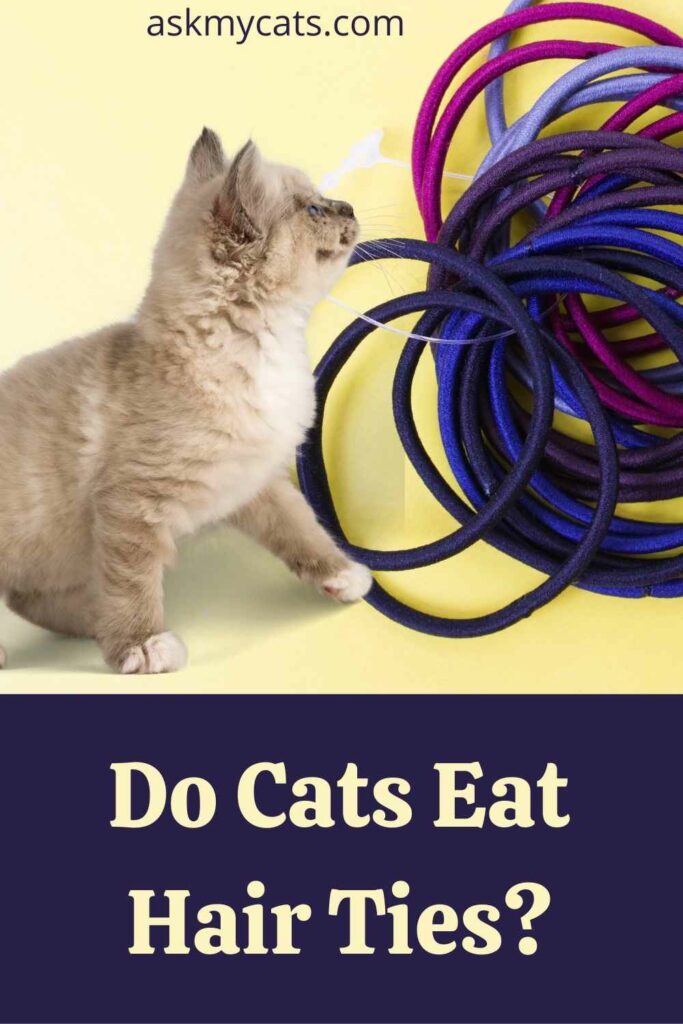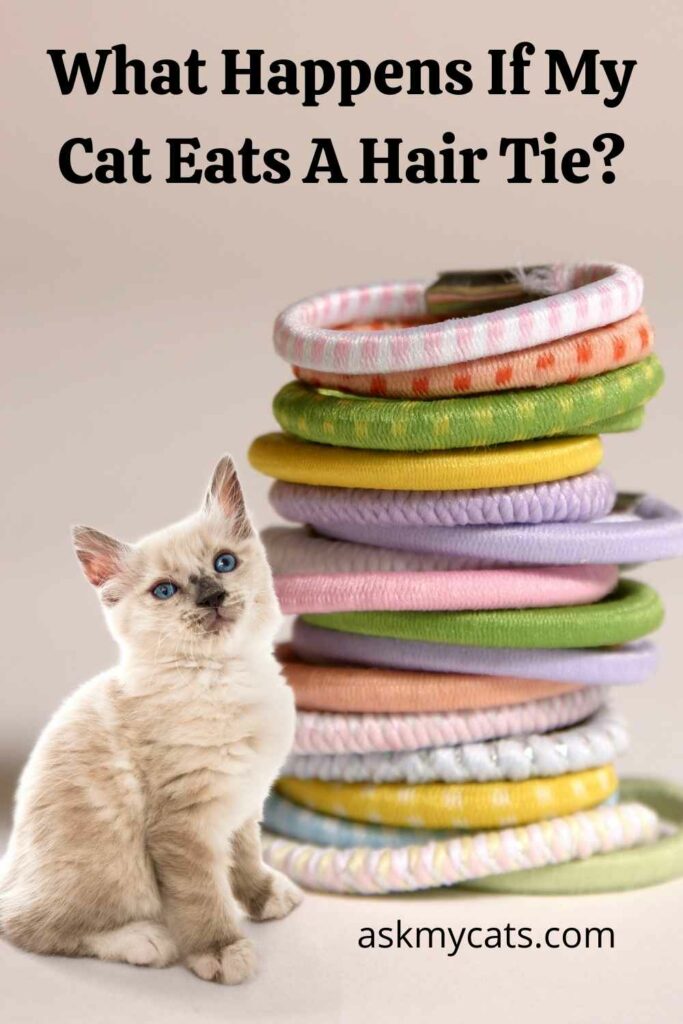If your cat has a thing for hair ties, you’ll have to be extra careful to keep them safely tucked away. Hair ties are equally simple to swallow as a string since they get caught on the tongue. String or hair ties can be fatal if eaten.
Cats like hair ties because they are attracted to string like objects and their feline instincts gives signal to their brain to play with it.
In this article, we would discuss more about cats and hair ties.


Give Your Cat the Perfect Day
Get the Free Ebook!
Do Cats Eat Hair Ties?
Cats can’t eat hair ties and typically don’t want to, but if they chew on one, they could swallow it, so keep hair ties out of reach of your cat.

If your cat ate a single hair tie, simply keep a watch on them and closely inspect their faeces until they pass it.
It might take up to a week, so don’t panic if you don’t see the hair tie right away. As long as your cat is eating, drinking, and acting normally, there’s no cause to be concerned.
Because the hair tie may not come out as entire as it went in, it may emerge in the faeces over several days, so keep monitoring the stools every day until you’re confident the full hairband has been pushed out.
Even if you don’t see the hair tie after many days, some cats may not show any signs of pain.
However, if the hair tie does not come out, it will become lodged in the gastrointestinal system, and the longer it is there, the more hazardous it will become.
In fact, your cat’s health might swiftly deteriorate, thus it’s critical to inspect the stools on a daily basis. You should contact your veterinarian if the hairband does not appear within 6-7 days.
Giving your cat a cat laxative or altering their diet to something that helps lubricate the GI system, such as pumpkin or puree, will help them push out the hair knot.
Cats that are used to eating dry food may benefit from switching to wet food. For a few days, stop giving your cat dry food and maintain him on a wet food-only diet.
Induce vomiting in your cat is a dangerous technique that should only be attempted at home if absolutely necessary and with your veterinarian’s consent.
In addition, this technique is only effective within two hours of intake.
Why Are Cats Obsessed With Hair Ties?

Cats are obsessed with anything they are able to explore and hunt. If your cat is feeling bored in her life, she may turn to eating and chewing on hair ties as a form of entertainment.
Because of the unpredictable nature of the object—it simulates the movement of a mouse or other small prey—cats are addicted to small, circular items, although not all cats go wild for rings. Some cats just have a higher level of obsession than others.
The difficulty is that, unlike bags and boxes, which are composed of paper, hair ties, milk rings, and rubber bands, are made of non-digestible materials such as metal, plastic, or rubber.
It’s not a huge issue if cat consumes a piece of cardboard now and again.
Although their systems will breakdown it as part of the digestive process (as long as they don’t consume huge amounts at once), many of the rings cats play with can cause significant injury if swallowed.
Is It Bad For Cats To Play With Hair Ties?
Yes, it is bad for cats to play with hair ties because he can swallow it accidentally.
Hair ties may appear innocuous when played with, but if eaten, they can cause damage to your cat’s digestive tract, necessitating surgical removal. As a result, it’s critical to keep a careful eye on your cat or provide other toys.
Are Hair Ties Toxic To Cats?
Yes, hair ties are toxic to cats because ingestion of string or hair ties can be deadly.
Hair ties and rubber bands are attractive to your pets, but if you’re not careful, your pet might choke. Cats who enjoy playing with rubber bands may wind up breaking them into little bits, which may become stuck in their throat and cause them to choke.
What Happens If My Cat Eats A Hair Tie?
Choking and gastrointestinal obstruction are two of the most serious issues that cats face when they eat a hair tie.

You’ll know right immediately if your cat chokes on the hair tie, and you’ll need to act fast, either intervening yourself or transporting your cat to the emergency hospital.
A gastrointestinal obstruction may be difficult to detect, which is why this disease is so hazardous and need constant monitoring of your cat.
When comparing cats and dogs, most cats, regardless of breed, stay very tiny.
Because cats have a smaller mouth and throat, it’s simpler for them to choke on tiny objects like hair ties.
If a cat eats an elastic thread, rubber band, or hair tie, it may become caught in their mouth, between their teeth and tongue, or form a blockage in their throat, resulting in asphyxia.
Examine your cat’s lips to see if the hairband is visible. Preventing asphyxia is as simple as removing the object with your fingertips before it gets down the throat.
If you can’t find the hair tie, you have a medical emergency, and you should go to your local veterinarian or animal emergency facility.
In this scenario, time is of the essence, so call ahead to ensure that the emergency room is ready when you arrive.
Although a single hair tie is unlikely to create a complete obstruction, a hairband might cause a partial blockage or other gastrointestinal difficulties, such as slowing down the digestion process, depending on the size of the cat.
A partial blockage differs from a total blockage in that the cat may still digest liquids, some types of wet food, or tiny bits, but a cat with a complete obstruction of the intestines will not pass food or water.
If your cat chews on hair ties, it may be accumulating a large number of them in the intestines, putting it at danger of significant problems.
At least one verifiable incidence of a cat nearly dying after eating too many hair ties has been documented.
Cats suffering from severe GI obstruction show a combination of two or more of these symptoms:
- Vomiting
- Diarrhoea
- Constipation
- Lethargy
- Abdominal Discomfort
- Whining
- Lying in unusual positions
- Changes in their normal behaviour
The hair tie is generally removed after surgery to eliminate a gastrointestinal blockage (s). It’s a risky and intrusive treatment that can lead to death.
The veterinarian will need to identify the hair ties prior to surgery, which is why x-rays are generally necessary. Unless the hair ties include metal components, it may be difficult to identify them.
A portion of the intestine must be removed in severe blockage situations before the remaining intestine can be reattached.
Many factors influence recovery, the most important of which is the pet’s clinical picture. This treatment, as well as the tests required before and after it, is extremely costly, and it is far less expensive to just ensure that your cat does not have access to it.
How Do I Know If My Cat Swallows A Hair Tie?
If your cat eats a hair tie, they may not show any symptoms until it passes through their faeces.
You might not even realise they’ve eaten it until it shows up in their faeces. If it becomes lodged in their intestines, though, your cat will most likely develop symptoms.
However, you may notice these symptoms if your cat has eaten a hair tie:
- Vomiting
- Lack of appetite
- Lethargy
- Hiding
- Abdominal pain & swelling
- Constipation
- Diarrhoea
Can Cats Choke On Hair Ties?
Cats can choke on hair ties and lead to serious problems.
Can Cats Poop Out Hair Ties?
Yes, cats can poop out hair ties if they are properly digested.
A hair tie can occasionally pass through a cat’s mouth, but there’s no way of knowing whether it will pass on its own or become trapped until symptoms appear. If your cat is lucky, the hair tie will pass through their stomachs without causing any discomfort, and you will see it in their faeces.
How Do I Get My Cat To Stop Eating Hair Ties?
To begin, make certain that hair ties, yarn, and other similar things are out of reach. Second, you may offer your cat with safe-to-chew cat toys, which will ideally reduce the desire to gnaw on harmful objects.
If your cat eats a hair tie, take them to an animal hospital right away so that doctors may induce vomiting if required. This is the best-case situation, because a hair tie can be vomited up with no further testing or treatment required.
Frequently Asked Questions
What can I use instead of a hair tie?
Ribbons, hair bands, bandanas, bobby pins, hair clips, heck, even chopsticks and pencils are all great alternatives to putting your hair up with a hair tie or just keeping it out of your face.
Why does my cat put hair ties in his food bowl?
Most cat owners would know this behaviour, and it has been misinterpreted as a sign of territoriality in the past. Some cat psychologists believe that cats lack a concept of self.
Why do cats like rubber bands so much?
Other cats enjoy eating unusual foods, while some cats enjoy eating really unusual foods. Instead of dismissing your cutie’s love for chewing rubber bands as merely bizarre, consider the possibility that she is suffering from pica, a compulsive eating disorder.
Final Words
Your cat needs to play to maintain a healthy lifestyle, but you should give them with appropriate pet toys intended for their safe enjoyment, rather than allowing them to play with everything they find.
It’s simple to protect your cat from these potentially fatal accidents: keep your hair ties out of reach of your cat and don’t leave them lying about the home.
Please leave your questions about your pet friend’s feeding habits in the comments section below. We’ll get back to you as soon as possible.
